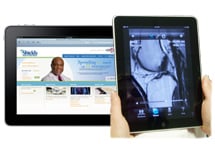OK -- the iPad is just plain cool! And this “WOW” factor gets you pretty far in the world of high-tech medical imaging. The iPad is truly irresistible. It’s light weight, compact, and portable with a multi-touch screen. It makes you want to hold it and show it to everyone and anyone. And that’s the key to why it, and future generations of like technology, will revolutionize medicine.
Right now our desktop computers can be more of a barrier than an aid to communication between a patient and a clinician. The computer monitor is, quite literally, a physical barrier in the physician’s office! The doctor sits at his desk or workstation looking at a computer screen and looking away from you, the patient. How comforting or reassuring is that? Especially when you are talking about your symptoms or explaining how you got injured. While some physicians and nurses have access to netbooks and laptops on rolling carts these are clunky, physical distractions. Why? They don’t promote dialogue and eye-to- eye contact. And with the increasing (mandated) computerization of medical records [a very good idea I might add] there’s no easy way around this.
Until the iPad!
So let’s imagine the medical visit of the very near future. Your doctor walks into the exam room to talk to you. She pulls up a chair. Instead of looking at a computer monitor she has an iPad on her lap. While listening to you explain the reason for your visit you are at eye level with your physician. Maybe she uses a pen and paper to write a few notes, or look up your records on the iPad. Sure, if they have to do a lot of typing then a keyboard and computer screen are the way to go, but this isn’t the majority of doctor visits, and many doctors dictate notes using voice recognition software during or at the end of the visit anyway.
When it’s time to look up your MRI or blood test results, the doctor taps the iPad a few times and glances at the screen. Then, she hands it to you to look at. This is tremendously empowering, and really impossible with a desk top computer. Together you look at the images and she points out where the problem is with your knee and what can be done to help you. Nice! This is really helpful for those of us who are more visual learners. Plus you can always ask for a CD of the images for your own medical file (remember my prior blog article?).
The symbolism of the doctor and patient communicating and enabling the patient to control his/her information is inspiring and empowering. It just might help us move from some unfounded fears of sharing medical information through technology [granted there are necessary steps to be taken to protect your information].
By the way, every time I refer to the “iPad” I am referring to current technology and urge us all to adapt and adopt the best device available at the time. The vendor is not important, it’s how the technology works and how it feels that counts.
In practice, we continually evaluate and work on ways to leverage technology to improve access to information for physicians and patients. As we do so, we empower patients to take control off their well-being and medical information, including imaging studies. Tools like the iPad will undoubtedly play an ever increasing and critical role in medice, and we’re going to be ready!



